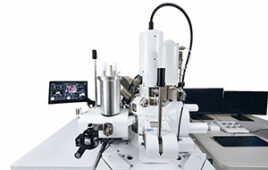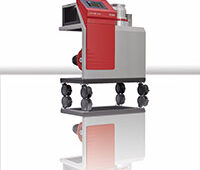 Graduated cylinders are a common type of laboratory glassware. They are an elongated cylindrical vessel, with graduations to indicate the volume of liquid held, and typically a spout to ease pouring. Graduated cylinders very similar to beakers, but while beakers are relatively short and wide to facilitate storage and mixing, graduated cylinders are taller and thinner to increase the accuracy of measurement. Due to their tall narrow shape, graduated cylinders generally require a flared base to make them more stable when stood upright. Mixing cylinders may omit the spout, enabling a stopper to be fitted.
Graduated cylinders are a common type of laboratory glassware. They are an elongated cylindrical vessel, with graduations to indicate the volume of liquid held, and typically a spout to ease pouring. Graduated cylinders very similar to beakers, but while beakers are relatively short and wide to facilitate storage and mixing, graduated cylinders are taller and thinner to increase the accuracy of measurement. Due to their tall narrow shape, graduated cylinders generally require a flared base to make them more stable when stood upright. Mixing cylinders may omit the spout, enabling a stopper to be fitted.
The primary use of graduated cylinders is measuring liquids. The tall narrow shape means they have a greater measurement precision and accuracy than a beaker or flask. The continuous graduation also means they can measure a relatively wide range of different volumes. However, they are considerably less accurate than instruments such as volumetric flasks, pipettes or burettes.
Graduations may be arranged and calibrated for different purposes. Graduations which increase in value from the bottom up are designed to measure while filling, while graduations which increase from the top down are intended for use when pouring. Some graduated cylinders have a double scale for ease of reading when filling and pouring. They may also be calibrated to indicate the volume of liquid contained by the cylinder or the volume delivered. Cylinders calibrated for the liquid contained are marked ‘TC’ while those calibrated for the liquid delivered are marked ‘TD’. The volume delivered will be slightly less due to traces left in the cylinder when pouring.
Different materials may be used depending on the application. Larger cylinders are typically plastic, such as polypropylene, as this is more easily handled and less fragile than glass. Borosilicate glass may also be used, providing thermal shock resistance as well as being inert, transparent and easily cleaned.
Graduated cylinders occupy a useful middle ground between beakers and pipettes – providing more accuracy than a beaker but more convenient storage than a pipette. They are therefore used in many chemical, biological, clinical and industrial laboratories, especially industrial testing. They provide a convenient easily used container to store and mix liquids when a beaker is not quite accurate enough.





Tell Us What You Think!